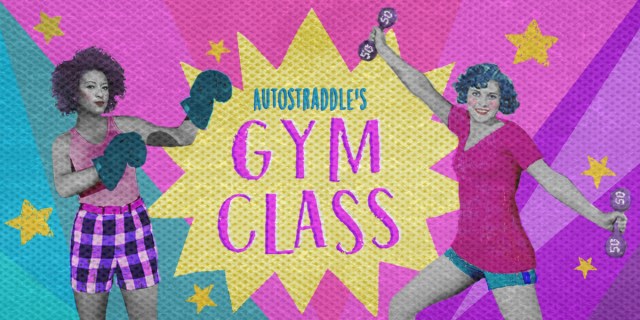
Where I live, in rainy Seattle, it’s cold and wet and blah outside from November to May. My favorite way to warm up and shake off impending hibernation is to exercise. Last fall, I tried something new and joined a CrossFit gym. This workout has it all — cardio, weightlifting, rowing, kettlebells, and more — and you can do it indoors. It’s the perfect activity to get you through the winter weather and beyond!
Intro to CrossFit
CrossFit, according to the program’s official website, is “constantly varied functional movements performed at high intensity … reflect[ing] the best aspects of gymnastics, weightlifting, running, rowing and more.” Because workouts are intense, they are also quick, with athletes attempting to finish a prescribed set of exercises within a time window or in the fastest time possible. Televised events like The CrossFit Games showcase the strongest competitors (and give the sport a heavily muscled, high-school-sports aura). CrossFit has its critics, who claim the combination of heavy weights, complex lifts and an emphasis on speed set participants up for injury. Throw in a focus on food (some CrossFit gyms push the Paleo diet), and the sport can seem overly intense at best and fanatical at worst. And I must admit: I used to be one of the haters. Especially coming from a powerlifting background, it just didn’t seem safe to combine big, challenging movements like deadlifts or squats with a ticking clock.
So why is CrossFit the topic of this Gym Class? Well, I finally tried it for myself and realized it’s really, really fun.
I came to CrossFit with 15+ years of athletic experience, primarily in basketball, rowing, and powerlifting. I love trying new sports, but CrossFit classes were my first experience with combining several of my favorite activities into one well-planned workout. Despite my sports background, I still have so much to learn that’s particular to CrossFit, so my curiosity is engaged each class. Each workout of the day, or WOD, can be scaled in difficulty, so I leave every class feeling like I gave 100 percent. Add in the community aspect of the sport — my gym is big on friendliness and supporting each other during workouts — and I was hooked after my first week. If you’re looking for a physical challenge, a supportive team environment, and variety in your workouts, I think you’ll enjoy CrossFit, too.

Things You’ll Need
- At a CrossFit gym, all equipment is provided, but you can get a head start with:
a jump rope - good cross-training shoes (I like Nike Metcon 3s)
- a timer
Basic Technique
Typical CrossFit workouts are short (12 – 20 minutes) and intense. Workouts usually feature strength-building exercises in combination with bursts of cardio (jumping, sprinting, rowing, and so on) to keep your heart rate up. When you join a gym, you’ll follow that gym’s WOD plan. This is something I love about CrossFit, in comparison to weightlifting or general training on my own: I don’t have to do any planning in advance to prepare for workouts. I just show up, gather my equipment for the WOD, and get ready to work when the coach starts the clock.
To do a WOD “Rx” is to do it with the prescribed weights, activities and reps; there are different Rx standards for men and women for each workout. For example, a WOD might be 4 sets of 20 pullups, 20 box jumps (Rx box heights are 24″ for men and 20″ for women), and 20 pushups, for time (meaning, as fast as you can complete the exercises). But any WOD can be modified, or “scaled,” to make it doable: I might tackle the example workout by doing my pullups with an assistance band, a 16″ box, and pushups with knees down when my strict pushups fail. Think of the WOD as your workout template, always adjustable to your fitness level; your coaches will outline how to safely scale each exercise before the WOD begins.
At the end of each WOD, you record your time (or how close you got to finishing). This way, you can track your progress as you get faster, stronger, and closer to doing full-Rx workouts.

Training & Sample Workouts
For this sport, it’s best to work out at a CrossFit gym, where you’ll benefit from direct coaching, good-quality equipment, and a team mentality that makes even the toughest exercises fun. I won’t provide sample WODs here; they vary by gym, and many activities should be done with a coach, for safety. Instead, I’ll focus on how you can best prepare if you want to walk into your new CrossFit gym with some basic skills in place.
A good gym will welcome athletes of any level, from total beginner to experienced CrossFit pro; don’t feel like you can’t do CrossFit if you can’t do a pushup! But also know you will be doing lots of pushups (scaled, as needed), so if you start working on them now you may feel more comfortable when you see them as part of a WOD.
Bodyweight Exercises
Ah, the dreaded pullup and pushup. I’ve hated these since failing the junior-high Presidential Fitness Test (the one with that weird sit-and-reach flexibility board). Pullups and pushups — which rely heavily on upper-body strength — can be especially challenging for women, but they are staples of CrossFit programming. So I’m working on them, and so can you!
Pullups:
If you’re just starting with these, try working up in weight on the lat-pulldown machine. Another good way to progress is with banded pullups: loop a resistance band over the pullup bar, hook your feet into the band, and practice good form in that supported position. Work your way towards using a band with less support.
Pushups:
To progress with these, think about your body in a vertical position (easiest) descending to a horizontal position (hardest). A beginner can start with wall pushups: standing arms’ length from a wall (vertical body), put your hands on the wall, lean forward until your chest touches, and push back to extended arms. When that’s too easy, descend: get your body into a 45-degree position (maybe with your hands on the edge of a desk) and do pushups; descend further (maybe with your hands on the bottom step of a staircase) as you progress, until you can do a pushup on the ground. Or, another modification: on the ground in pushup position, keep your knees down during the movement.
Jumping
Jumping is a key part of many WODs, and often what provides the heart-rate-boosting cardio portions of workouts. To prepare for CrossFit workouts, get comfortable with a jump rope: try intervals (1 minute jumping rope, 30 seconds rest, and repeat without breaks), and see if you can attempt some double-unders, which show up frequently in WODs. Another common exercise is the box jump, where you jump up onto a 20”-tall box. You can practice the movement with smaller platforms (as long as they’re safely stable) like stairs or benches. Start with 10″ jumps and see if you can work your way up. (Note: My gym has 16″ boxes for beginners, and I’m still working my way up to the 20″ box! There’s no shame in scaling exercises — the point is to push yourself to your own personal-best workout.)
Jogging
Most WODs (if they feature running) only include short sprints. But improving your overall cardio fitness is beneficial to most any exercise program. A steady-state 30- to 45-minute jog once or twice a week will be good cross-training for fast-and-intense CrossFit workouts. Throw in some sprints (30-second, 1-minute, and 3-minute sprints are a good place to start) to work on your speed and recovery. (Often, a run is the “break” in the middle of a tough WOD, so the more comfortable you are with running, the better you can use mid-WOD runs as recovery time.)
Barbell Skills
One of the things I’ve enjoyed most about my CrossFit gym is learning to practice Olympic lifts — the snatch and the clean-and-jerk — and the various building blocks that make up those movements. Barbells are core parts of many WODs, and most gyms give the option of using a women’s bar, which is thinner to allow for proper grip if you have smaller hands.. If you’re looking to build some barbell skills, check out the Gym Class on powerlifting for a basic introduction. The squat and deadlift transfer particularly well to CrossFit (and are even featured in some WODs), and being comfortable with the barbell will help you as you learn the more explosive lifts like the clean, snatch, and push-jerk.
Rowing
Rowing is included in WODs as a heart-rate booster: at my gym, we usually row for calories, which means a strong, controlled pace to reach a calories-burned goal as fast as possible. The Gym Class on rowing has lots of tips for how to use the erg machine safely and understand the machine’s display of pace/calories/time/etc. The most important thing to remember on the erg is: use your legs. That’s where your power comes from (not your back or arms). Ask a coach for help any time you think your rowing form could use adjustment; the coaches are there to keep you safe.
HIIT
High-Intensity Interval Training (HIIT) is a big part of what makes CrossFit WODs so tough and so effective. You push to max effort but it’s only for a short time, and some WODs include rest intervals. You can prepare for HIIT-style workouts with running sprints, rowing sprints (see the rowing Gym Class for a sample HIIT workout), or intervals of a bodyweight exercise like burpees. Yep, get used to burpees — they are a popular component of WODs.

Good-to-Know Tips
With this sport, choosing your gym (or CrossFit “box”) will be very important. Your gym will be the center of your workout community, so you’ll want to choose a place with a clientele that makes you feel comfortable and coaches that help you feel safe and competent in your workouts. Here are some things to look for in a gym:
- Schedule: What times are classes offered? Can you make at least 3 per week, reliably, to get in the habit of attending?
- Equipment: A good gym will have well-kept barbells and plates, kettlebells, dumbbells, rigs for pullups, a weight room with racks for squats, erg machines, and boxes for jumps. The equipment is constantly used, so it doesn’t have to be spotless, but it should be sturdy and serviceably clean.
- Coaching Style: When learning so many new movements (especially those that involve heavy weights), it’s critical that you trust your coaches to guide you through the learning process and provide a safe environment during workouts. There’s pushing you to work hard and pushing you to work too hard, and if you feel that a coach is being reckless, aggressive, or rushing you into performing certain exercises, pay attention to that feeling! I chose my gym because the coaches are well-trained (with several certified weightlifting folks on staff) and I liked the friendly vibe of the place.
- Onramp Training: My gym has a mandatory 2-week onramp course for all members who are new to CrossFit; in onramp, you work with a group of fellow beginners to learn safe technique for all the basic exercises in WODs. I think this is a great policy and one you should look for in a gym. Another perk my gym offers that I recommend: every week, there are classes labeled “beginner friendly” on the schedule, so those who are new to the gym can feel more comfortable as they continue to learn beyond the onramp course.
- Groupon Is Your Friend: This is a standard Gym Class suggestion for trying a new activity — get a Groupon deal and try it for a limited time (and for less money!), so you can see if you like the exercise, the people, and the location before paying full membership dues.
- The Paleo Question: Some gyms push Paleo-style eating. My gym is not run that way — the focus is on workouts and building community. However, my gym does offer optional Nutrition Challenges a few times each year, so athletes who want to track their progress (either cutting weight or adding muscle) while also tracking their eating can do so in a competition-style event. It’s fun if you want to try it and not an issue if you don’t. Make sure your gym has a philosophy that matches your own in terms of nutrition-tracking.
WOD Time!
Five months into my membership, my CrossFit gym has become a place I look forward to going each week. I’m making progress on my Oly lifts and getting better at pullups, and I love hitting new benchmarks that show I’m getting stronger. If you’re looking for a challenge and a great workout, give some of the skills in this Gym Class a try and then check out your local box!








Comments
This series continues to be awesome *muscle emoji*
My personal experience with CrossFit has been….mixed. On the positive side, it is always a killer workout and, as you said, you’re going to leave feeling like you gave everything you had. The variety of the workouts means you learn a lot of new skills, which you can then use on your own time.
However, one big downside is the cost – in my area a CrossFit membership is around $120/ month, almost 3x the cost of the full service traditional gym I go to now. You are getting (hopefully good quality) personalized instruction and support for that price, but it’s definitely not cheap.
The second downside for me was mental – the fast pace of the instructions and somewhat competitive environment led me to ignore my own body’s signals, which led to injuries…I have since learned that I do much better physically and mentally when I learn 1 new exercise at a time, and incorporate it into my own routine slowly!
All that said I would still encourage anyone to give it a try. If nothing else you’ll definitely learn some stuff!
Only $120/month?? Lucky you! Mine’s more like $200. But they say what you’re really paying for is the coaching, and it’s comparable (or in some cases even less) than other class style workouts like Orangetheory or Soul Cycle, which is a fortune.
I’ve been doing Crossfit now for 3 months and absolutely love it. Love the intensity and the weights which are great for my already strong body that is ambivalent to long cardio workouts (as far as slimming down goes.) I’ve found an excellent community as well, which seems to a commonality among gyms.
My gym (BRFC in Indianapolis, the best Crossfit gym in Indy, for anyone who may be interested), focuses on personal improvement and regularly emphasizes it’s not a competition, other than to improve yourself, which I also appreciate given I’m competitive at heart and can’t manage some of the workouts like others can. Yet.
Also. If you feel gross about the terminology (box, WOD), I stubbornly refuse to use it and refer to the workouts as “class” and the building as a gym. If that helps.
Crossfit is also great for enneagram 8s, enneagram and Crossfit being two of my chief interests. I feel personally victimized by Autostraddle dot com.
‘most gyms give the option of using a women’s bar (35 pounds instead of the 45-pound standard bar) if needed’
OHMYGOD not to be that person but this is my biggest pet peeve regarding gym culture (outside of weightlifting gyms). I HATE when the women’s bar is presented this way, as if one should be using a men’s bar if they’re ”strong enough” and it makes women not realize why they’re struggling with certain movements (especially front squats). It also presents the women’s bar as specialty equipment while the men’s bar is standard and that is BULLSHIT as far as weightlifting goes and keeps women out of strength sports as the equipment they need is not provided and they don’t even know that that’s the problem because they are strong enough to use a men’s bar.
The women’s bar exists because it is a)shorter and most importantly b) thinner. If you have small hands/are short/have a smaller build this is crucial in weightlifting because you utilize hookgrip and will be resting the bar on the front of your shoulders where there is limited space (this is why it’s a ‘women’s bar’ as this applies to practically all women). If you are struggling with the front rack position using a men’s bar – try a women’s bar! It might fit better on your shoulders! If you struggle with hookgrip/your grip’s not solid with higher weights – switch to a women’s bar so you can wrap your hands around the bar better! That is the entire purpose of the women’s bar, not that it is lighter (because you will be loading weight onto it as you go and it will not be lighter at all after that).
This has been my Let Women’s Bars Become Standard In Gyms 2k18 rant, sorry for my outburst.
Hahaha. Exactly. You can put as much weight as you want on the bar.
Now, if only my gym had a pull up bar that fit my delicate little lady hands…
That is a massive downside to the culture. Our lead coach who taught the intro class referred to us as girls and boys (which, given he’s exceptionally knowledgeable about fitness and movement and he’s speaking to newbies isn’t entirely invalid) gave me a moment for pause.
Hi Eva, thank you for your comment! I didn’t introduce the women’s bar very well, and I apologize. I’ll see if I can get the article edited to mention that it’s thinner to allow proper grip for those with smaller hands.
It’s ok! I realize it doesn’t come up much outside weightlifting, but in ‘Olympic lifting’ women’s bars are standard for women. If you are a woman you should probably use a women’s bar for the snatch and c&j – it will be safer and it will allow you to lift more weight, not less :)
Yes, I’d never seen a women’s bar until I started CrossFit and started learning Oly lifts! (Part of this issue is that, as a self-taught lifter, I was learning from books & training materials aimed at young cis men, which did not cover women’s bars & their purpose.) I’m tall with bigger hands, so with powerlifting I can get a good hook grip for deadlifts with a men’s bar. But in CF for Oly lifts I use a women’s bar and it’s been a lot more secure in terms of grip.
In any case, it is my goal to get many more women into strength sports & help make these sports seem accessible, and I fully support your Let Women’s Bars Become Standard In Gyms 2k18 initiative!
The place you might have seen them and not realized is if you’re ever watched women weightlifting in a competition (or in the Olympics), but yeah very few gyms have them and it’s a shame.
Outside of the snatch and C&J women’s bars can be generally helpful for women with narrow shoulders or smaller builds for back squats and front squats and obviously having a shorter bar is helpful in overhead movements if you are short.
For an example, the difference in my front squat between a men’s bar and women’s bar is a full 20kg/45lbs, because the bar sits securely on my shoulders which allows me to actually push the weight up. It annoys me so much that so many women are missing out on things like front squats because these bars aren’t available and when they are, no one thinks to advise women to use them unless they’re total beginners and need a ‘lighter bar’, which implies they should switch as they get stronger which they most certainly don’t need to unless they want to do competitive powerlifting.
This is great knowledge, thank you for telling me! My gym does have a couple of ‘womens bars’ but theyre always described as being 15kgs instead of 20, rather than thinner. I have tiny hands and will totally try deadlifts with the thinner bar next time. I have such an issue getting a firm grip. This may make me dread deadlifts less!
This series is amazing, super detailed and thorough plus the Groupon suggestion is brilliant
Great work
Thank you, Carmen! :)